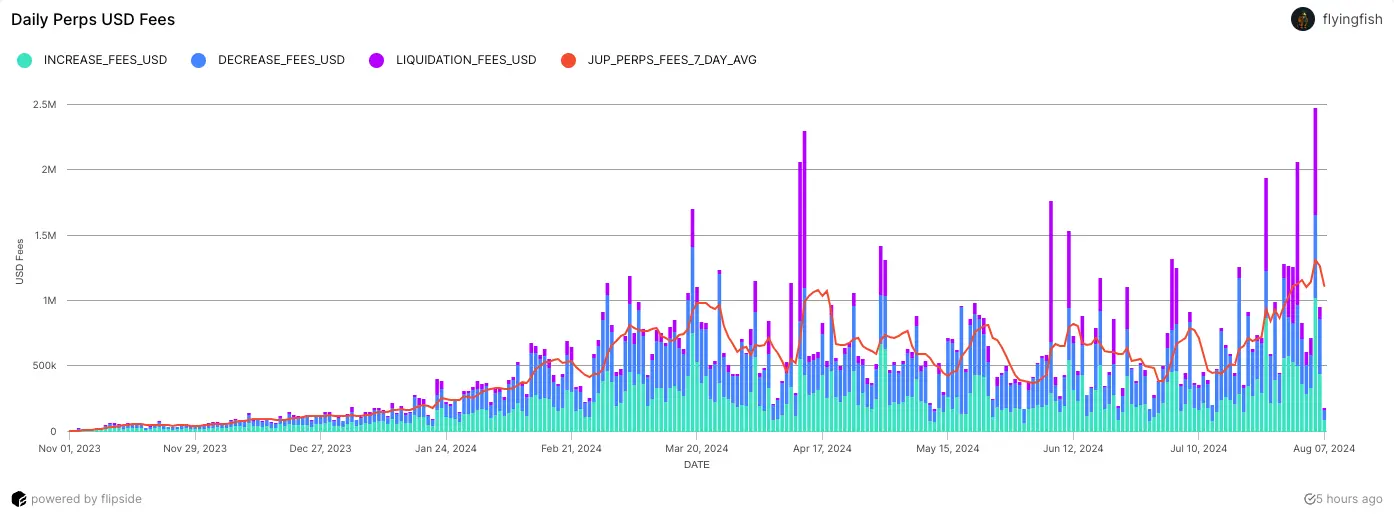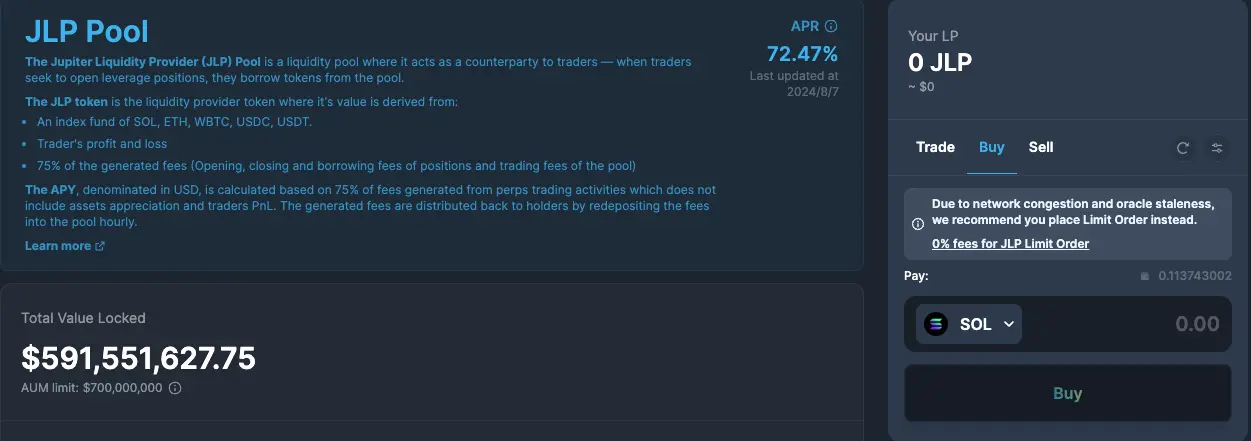Why is JLP, the "best dollar-cost averaging target" in the crypto world, so resilient?
Author: Luccy, BlockBeats
There are no gamblers who make money forever, but there are casinos that do. So, can we also make money by "investing in casinos" on-chain? After the launch of JLP, Jupiter seems to have provided an answer.
Since the beginning of this year, Jupiter's perpetual contract platform JLP (Jupiter liquidity provider) has become one of the best-performing and highest-yielding casinos. According to Dune data, on August 5 alone, the opening fee reached $2.475 million, while the fee for each position opened was only $0.0006. However, according to flyingfish data, from the beginning of this year to now, players trading contracts on Jupiter have only earned a total of $3.7 million, while they contributed $136.8 million in fees to JLP.

On August 5, the market plummeted, and crypto assets collapsed across the board, with Ethereum erasing its gains for the year and SOL also falling to $110. However, with the underlying assets being Bitcoin, Ethereum, and SOL, JLP's decline was smaller than that of the underlying assets, leading many to wonder why JLP is so resilient.
Contract Players: In Debt from the Moment of Opening a Position
On JLP, users' counterparty is the platform itself. When traders seek to open leveraged positions, they borrow tokens from the pool, with prices fed directly by oracles. This model is also known as "partnering to open a casino," where users make money while the platform loses money.
The JLP pool supports five assets: SOL, ETH, WBTC, USDC, and USDT, with contracts supporting leverage from 1.1x to 100x. Traders borrow relevant liquidity from the JLP pool, and after closing their positions, they either realize profits or losses and return the remaining tokens to the JLP pool.
For example, if a trader goes long on SOL at a price of $150 with 5x leverage, they borrow 5 SOL from the pool, worth $750. If the price of SOL rises to $160, the position increases to $800, and the trader takes profits. After closing, the trader must return the initial $750 principal, resulting in a total profit of $50. However, for the platform, since SOL has risen, the principal value is less than 5 SOL, meaning the platform's USDT-based funds remain unchanged while the coin-based funds are in a loss state.
If the price of SOL drops to $140, the position is only worth $700, and the trader stops out, meaning they must return the remaining $700 in assets to the platform and pay an additional $50. Due to the drop in SOL, the amount of SOL corresponding to the $50 increases, putting the platform's coin-based funds in a profit state, while the USDT-based funds remain unchanged. Similarly, shorting SOL would require borrowing stablecoins.
The biggest difference between JLP and typical perpetual contracts may be that the latter can experience negative rates. To keep the perpetual contract prices close to spot prices, platforms may subsidize interest rates, but in the case of JLP, there is no platform subsidy.
Whether in profit or loss, the principal for opening positions comes from the JLP platform. Therefore, whether going long or short, from the moment of opening a position, traders are in debt to the platform. According to the JLP Pool page, the current APR for JLP is 72.47%, but this data is updated weekly and may differ from actual earnings.

You can manually calculate directly on the contract trading page, as different pools have different rates, as shown in the borrowing rate in the image below. If we calculate using the SOL rate, it is 0.0028% per hour (x24 hours x365 days), resulting in an annualized rate of 24.53%. Similarly, Ethereum has an annualized rate of 16.64%, and Bitcoin has an annualized rate of 44.68%, leading to a total annualized rate of 85.58%.

From left to right are the contract-related fees for SOL, ETH, and WBTC.
JLP Investors: Earnings and Losses Smaller than Underlying Assets
The fees generated from trading are reflected in the platform token JLP. According to official sources, the value of JLP comes from three aspects.
First, 75% of the fees from opening positions, closing positions, borrowing, and trading fees from the liquidity pool. Since they can receive a share of the platform's fees, this part of JLP's net value is generally on the rise.
Second, it comes from the five underlying assets. Theoretically (as shown in the Target Weightage in the image below), the price of one JLP is composed of 44% SOL, 10% ETH, 11% WBTC, 26% USDC, and 9% USDT. The official platform page also calculates the net value of JLP based on these factors, which is currently $3.18.

The rise and fall of SOL, Ethereum, and Bitcoin will also cause JLP to change accordingly. Therefore, some community members believe that buying JLP at a low price is a good choice, as it allows them to benefit from the appreciation of the underlying assets while also earning platform fees.
However, a careful comparison of the fluctuations of JLP and other assets reveals that JLP's volatility is much smaller. The main reason is that 35% of JLP's value composition comes from stablecoins (USDT and USDC), which do not experience drastic price fluctuations.

To compare JLP's price increase more specifically, DeFi researcher @22333D calculated the price changes of JLP against equivalent amounts of SOL, Ethereum, and Bitcoin from May 7 to May 19, finding that JLP's increase was the smallest, with JLP rising by 5.3%, while the corresponding increases for SOL, Ethereum, and Bitcoin totaled 6.8%.
@22333D explained that the shortfall may come from the coin-based losses of the JLP platform. This is also the third source of JLP's value, which is the profits and losses of traders, and it is negatively correlated with JLP's price. If a trader makes a lot of money, the net value of JLP will decrease, meaning that the asset composition of JLP has been earned away by contract players, and vice versa.
Although in the short term, the platform may also be in a loss state, according to flyingfish data, since the beginning of this year, JLP's overall profits have been greater than its losses.

Treating JLP as an Investment?
Currently, you can directly purchase JLP through the Jupiter current price order on the JLP official website, achieving 0 fees. A portion of the purchased JLP comes from LP contributions, while another portion is newly minted JLP. Minting will stop when JLP reaches the TVL limit ($700 million), and the current TVL is $591 million.

@22333D pointed out that if you use SOL to purchase JLP, it is equivalent to converting 56% of SOL into stablecoins, Ethereum, and Bitcoin. Then, using 35% of the total JLP position to go long on SOL can achieve a hedged way of managing SOL.
If you purchase JLP with USDT or USDC, you can use 44% of the total JLP position to short SOL, 10% to short Ethereum, and 11% to short Bitcoin, effectively turning JLP into a stablecoin-based investment product.
In addition, JLP also has other arbitrage strategies, such as depositing JLP in the Solana lending platform Kamino, borrowing stablecoins, and then buying JLP to achieve leveraged mining. However, due to the casino factors of JLP, its price carries uncontrollable risks. Whether as a contract player or a token investor, one must handle it with caution and DYOR.










